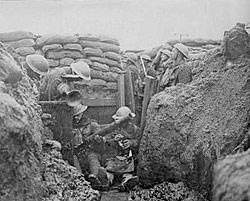
Unit 5: Crisis and Change
Lesson A: Competition Leads to Global Conflict
Lesson Overview
The relationships among the countries of Europe in the nineteenth century set the stage for a massive war that spread across the globe between 1914 and 1918. The growth of militarism, a web of alliances among European countries, imperialism, and a growing sense of nationalism in many European countries pushed the continent of Europe into
World War I.
Key Questions
- What were the causes of World War I?
- How did nationalism contribute to a declaration of war between European countries?
- How did World War I become a global war, when it started out as a dispute between the countries of Europe?
Student Outcomes
- Examine the role of nationalism in the decline of the Ottoman Empire, including the retreat of the Ottomans from the Balkans and the Black Sea regions.
- Assess the importance of nationalism as a source of tension and conflict within the Austro-Hungarian Empire.
- Describe the growth of European militarism and its impact on the outbreak of World War I.
- Explain the formation of European alliances and its impact on the outbreak of World War I.
- Analyze the role of economic and imperial competition among European powers and its role in the outbreak of World War I.
- Assess the impact of German and Balkan nationalism on the outbreak of World War I.
- Analyze cause-and-effect relationships and multiple causation, including the importance of the individual and the influence of ideas. (Historical Thinking Skill)
Key Terms
Student Resources
- MAIN Causes of World War I Graphic Organizer (doc)
- Imperialism in the Italian and Russian Empires - Jigsaw Graphic Organizer (doc)
- Nationalism as a Source of Conflict and Unity - Jigsaw (pdf)
- Nationalism as a Source of Conflict and Unity - Jigsaw Graphic Organizer (doc)
- Causes of World War I Brief Constructed Response (BCR) (doc)
Chart of Activities
| Activities to Complete | Estimated Time |
|---|---|
| Pre-Assessment | 5 minutes |
| Key Terms | 5 minutes |
| Activator: The World 1900-1914 | 15 minutes |
| Opening: The Causes of World War I | 10 minutes |
| Activity 1: Long-Term Cause - Militarism | 15 minutes |
| Activity 2: Analyzing Arms Spending | 10 minutes |
| Activity 3: Long-Term Cause - Alliances | 10 minutes |
| Activity 4: Long-Term Cause - Imperialism | 15 minutes |
| Activity 5: Long-Term Cause - Nationalism | 20 minutes |
| Activity 6: Nationalism as a Source of Conflict and Unity | 45 minutes |
| Activity 7: Check for Understanding - Causes of World War I | 10 minutes |
| Activity 8: Immediate Cause - Assassination of Franz Ferdinand | 10 minutes |
| Activity 9: World War I Begins | 15 minutes |
| Review and Assessment | 35 minutes |
| Lesson Summary | 5 minutes |
Lesson Completion Time
The total estimated time to complete this lesson is 225 minutes.
Page Notes:
[1] Source: This image from http://en.wikipedia.org/wiki/File:Trencheswwi2.jpg is in the public domain because its copyright has expired.



